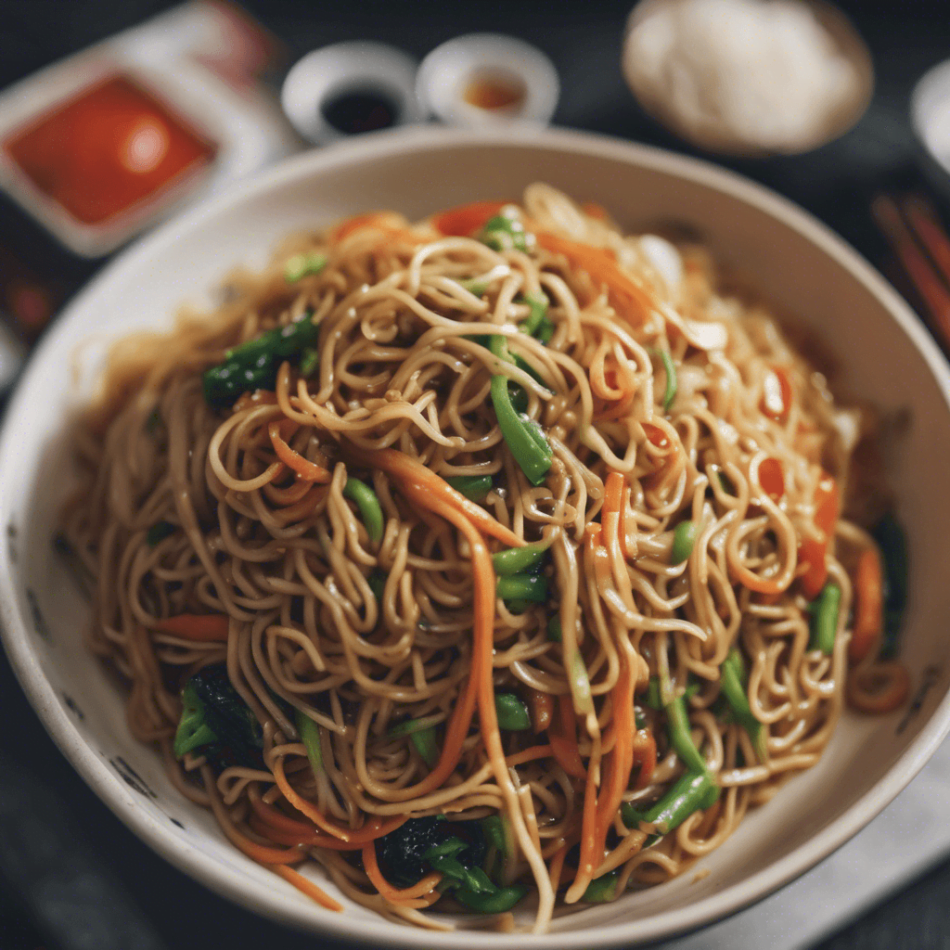Ingredients: 8 ounces of chow mein noodles 2 tablespoons of vegetable oil 1 onion, thinly […]
Ingredients:
- 8 ounces of chow mein noodles
- 2 tablespoons of vegetable oil
- 1 onion, thinly sliced
- 2 cloves of garlic, minced
- 1 red bell pepper, thinly sliced
- 1 carrot, julienned
- 1 cup of snow peas
- 1 cup of bean sprouts
- 2 tablespoons of soy sauce
- 1 tablespoon of oyster sauce
- 1 teaspoon of sesame oil
- 1/2 teaspoon of sugar
- Salt and pepper to taste
- Chopped green onions for garnish
Preparation:
Step 1: Boil the noodles
Start by boiling the chow mein noodles according to the package instructions. Once cooked, drain and rinse them under cold water to stop the cooking process. Set aside.
Step 2: Prepare the vegetables
In a large skillet or wok, heat the vegetable oil over medium-high heat. Add the sliced onion and minced garlic, and sauté until fragrant and slightly softened. Next, add the red bell pepper, julienned carrot, snow peas, and bean sprouts. Stir-fry for a few minutes until the vegetables are crisp-tender.
Step 3: Make the sauce
In a small bowl, whisk together the soy sauce, oyster sauce, sesame oil, sugar, salt, and pepper. This flavorful sauce will add a savory and umami taste to the dish.
Step 4: Combine everything
Add the cooked noodles to the skillet with the vegetables. Pour the sauce over the noodles and vegetables, tossing everything together to ensure the sauce coats every strand of noodle and every vegetable. Continue stir-frying for a few more minutes until everything is heated through.
Step 5: Serve and garnish
Transfer the Cantonese-style veggie chow mein to a serving dish. Sprinkle some chopped green onions on top for a fresh and vibrant touch. This dish is best enjoyed hot and fresh, so serve it immediately.
Consequences:
Cantonese-style veggie chow mein is a delicious and nutritious dish that offers several benefits. Firstly, it is a great way to incorporate more vegetables into your diet. The colorful array of veggies in this dish provides a variety of vitamins, minerals, and antioxidants that support overall health and well-being. Additionally, the use of chow mein noodles adds a satisfying texture to the dish, making it a filling and satisfying meal.
Advantages:
– Quick and easy to prepare: With just a few simple steps, you can have a flavorful and satisfying meal on the table in no time.
– Versatile: You can customize this dish by adding your favorite vegetables or protein sources such as tofu or seitan.
– Suitable for various dietary preferences: Cantonese-style veggie chow mein is naturally vegetarian and can easily be made vegan by omitting the oyster sauce or using a vegan alternative.
– Budget-friendly: This dish is an affordable option for those looking to enjoy a delicious meal without breaking the bank.
Disadvantages:
– High in sodium: The soy sauce and oyster sauce used in this recipe can be high in sodium. If you are watching your sodium intake, you can reduce the amount of soy sauce or opt for low-sodium alternatives.
– High in carbohydrates: The chow mein noodles used in this dish are made from wheat flour and can be high in carbohydrates. If you are following a low-carb or keto diet, you may want to substitute the noodles with spiralized vegetables or shirataki noodles.
This Cantonese-style veggie chow mein recipe is perfect for anyone looking for a quick, flavorful, and nutritious meal. It is suitable for vegetarians, vegans, and those following a plant-based diet. Whether you’re a busy professional, a health-conscious individual, or simply someone who enjoys exploring different cuisines, this dish will surely satisfy your taste buds and leave you feeling nourished. So why not give it a try and embark on a culinary adventure to the vibrant streets of Cantonese cuisine?














